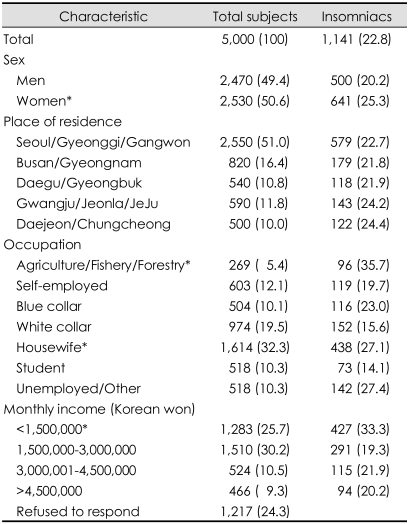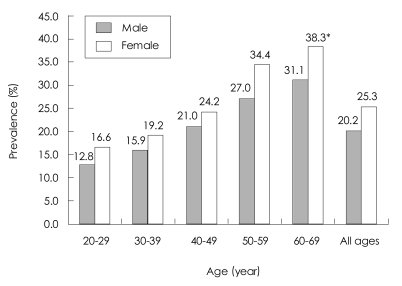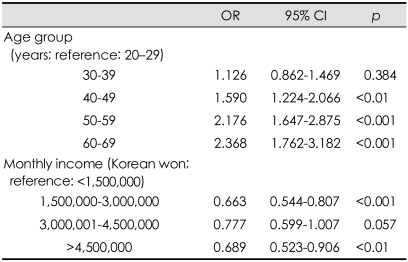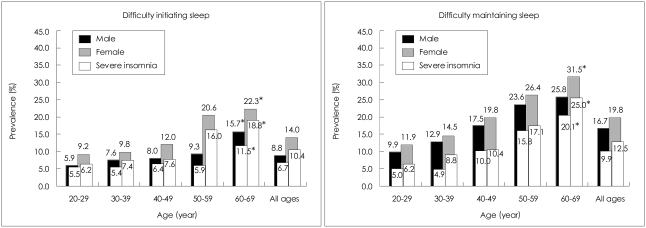Abstract
Background and purpose
Insomnia is a common complaint in adults. However, large epidemiologic studies of insomnia involving Asian populations are rarely reported. We performed an epidemiologic study of insomnia in a large Korean adult population.
Methods
A total of 5,000 subjects (2,470 men and 2,530 women) were interviewed by telephone. A representative sample of subjects aged 20 to 69 years was constituted according to a stratified, multistage random sampling method. Insomnia was defined as either any difficulty getting to sleep or getting back to sleep after waking in the night.
Results
More than one fifth (n=1,141, 22.8%) of the 5,000 subjects complained of insomnia, with the prevalence being significantly higher in women (25.3%) than in men (20.2%, p<0.001). Logistic regression revealed that the prevalence of insomnia increased significantly with age (p<0.001), being higher in those aged 60-69 years than in those aged 20-29 years (OR=2.368, 95% CI=1.762-3.182, p<0.001), and was lower in those with a monthly income of >4.5 million Korean won than in those with an income of <1.5 million Korean won (OR=0.689, 95% CI=0.523-0.906, p<0.01).
Conclusions
Insomnia is a common complaint in Korean adults, and its prevalence is similar to that in adults in Western countries.
Keywords: sleep initiation and maintenance disorders, insomnia, epidemiology, sleep disturbance, nocturnal sleep disturbance
Introduction
Sleep disturbance, especially insomnia, is a common complaint in adults, and it is associated with various physical and psychiatric disorders and accidents.1-3 The prevalence of insomnia in adults in Western countries reportedly ranges from 10% to 30%.4-6 However, large epidemiologic studies of insomnia involving Asian populations are rarely reported: the insomnia prevalence was 15.3% in a Singaporean study,7 21.4% in 3,030 individuals from the general Japanese population older than 20 years,8 and 17.0% for insomnia occurring on least three nights per week in 3,719 Korean individuals older than 15 years.9
We performed an epidemiologic study of insomnia in a large Korean adult population and compared the obtained data with those from a Korean study performed in 2002.9
Methods
Preparation of the study methods
This study formed part of a large population telephone-interview study of the epidemiology of restless legs syndrome (RLS) in Korean adults.10 Insomnia was defined as either any difficulty getting to sleep or getting back to sleep after waking in the night. The frequency of insomnia was categorized as every night, most nights (5 or 6 nights) a week, several nights (2 to 4 nights) a week, once a week, less than once a week, and rarely. We excluded subjects in the last group from the analysis since they were not clinically meaningful.
Subjects and survey procedure
A representative sample comprising 5,000 subjects aged 20 to 69 years was constituted from 42,641 telephone numbers according to a stratified, multistage random sampling method based on sex, age, economic status, and place of residence, and comprehensively interviewed using a computer-aided telephone-interview method. Samples were established based on geographical region (five Korean provinces), the population in the place of residence, sex, age (five strata: 20 to 29, 30 to 39, 40 to 49, 50 to 59, and 60 to 69 years), occupation, and income based on the 2000 Korean Census.11
Two questions on insomnia symptoms were asked: 1) Do you have any difficulty getting to sleep? and 2) If you wake up at night, do you have difficulty getting back to sleep? If the subject responded yes to either question, they were then asked to indicate the frequency within the five above-described categories.
This survey was conducted by trained interviewers from Taylor Nelson Sofres. Data were collected using a software package designed specially for this type of computer-assisted telephone survey.
Statistical analysis
All of the analyses were performed using SPSS 13.0 for Windows (SPSS, Chicago, III). The sampling error was ±1.39 points for a 95% confidence interval. We analyzed the data using the chi-square test for categorical data. Logistic regression analysis was used to compute the risk factors associated with insomnia symptoms.
Results
Study population
The 5,000 subjects comprised 2,470 (49.4%) men and 2,530 (50.6%) women, with 1,075, 1,235, 1,155, 784, and 751 of the subjects aged 20-29, 30-39, 40-49, 50-59, and 60-69 years, respectively. The percentages of the subjects from the Seoul/Gyeonggi/Gangwon, Busan/Gyeongnam, Daegu/Gyeongbuk, Gwangju/Jeonla/Jeju, and Daejeon/Chungcheong provinces were 51.0%, 16.4%, 10.8%, 11.8%, and 10.0%, respectively. The percentages of the subjects in the occupation categories of agriculture/fishery/forestry, self-employed, blue-collar, white-collar, housewife, student, and unemployed/other were 5.4%, 12.1%, 10.1%, 19.5%, 32.3%, 10.3%, and 10.3%, respectively. The percentages of the subjects with monthly incomes of <1.5, 1.5-3.0, 3.0-4.5, and >4.5 million Korean won were 25.7%, 30.2%, 10.5%, and 9.3%, respectively; 24.3% of them refused to state their income (Table 1). The sex, age, economic-status, and place-of-residence distributions of the study subjects were representative of the general Korean adult population.
Table 1.
Subject characteristics and prevalence of insomnia
Data are n (%) values.
*p<0.001.
Prevalence of insomnia and characteristics of subjects
More than one fifth (n=1,141, 22.8%) of the 5,000 subjects complained of insomnia, with the prevalence being significantly higher in women (25.3%) than in men (20.2%, p<0.001). This gender difference was similar for younger and older groups (Fig. 1). Difficulty maintaining sleep was reported by 18.3% of the subjects (19.8% of the women and 16.7% of the men) and difficulty initiating sleep was reported by 11.4% of the subjects (14.0% of the women and 8.8% of the men). Chi-square tests indicated significant differences in the initiation and maintenance of sleep. The prevalence of insomnia increased significantly with age (p<0.001), peaking at 34.6% in those aged 60-69 years (Fig. 1), and was higher in those working in agriculture/fishery/forestry, housewives, and those on a lower monthly income (Table 1), but it did not differ with the place of residence. Moreover, logistic regression revealed that the prevalence of insomnia relative to being aged 20-29 years was significantly higher in those aged 40-49 years (OR=1.590, 95% CI=1.224-2.066, p<0.01), 50-59 years (OR=2.176, 95% CI=1.647-2.875, p<0.001), and 60-69 years (OR=2.368, 95% CI=1.762-3.182, p<0.001). The prevalence of insomnia relative to having a monthly income of <1.5 million Korean won was lower in those with monthly incomes of 1.5-3.0 million Korean won (OR=0.663, 95% CI=0.544-0.807, p<0.001) and >4.5 million Korean won (OR=0.689, 95% CI=0.523-0.906, p<0.01)(Table 2).
Fig. 1.
Prevalence of insomnia in the general Korean population according to age group. *p<0.001.
Table 2.
Results of logistic regression analysis for insomnia
Difficulty initiating sleep occurred every night, on most nights (5 or 6 nights) a week, on several nights a week, once a week, and less than once a week in 2.6%, 1.9%, 4.0%, 2.0%, and 0.9% of the subjects, respectively; the corresponding prevalence rates for difficulty maintaining sleep were 2.5%, 2.2%, 6.5%, 4.0%, and 3.1%.
The prevalence of severe insomnia (occurring on least two nights per week) was 14.9%, with 8.6% reporting difficulty initiating sleep and 11.2% reporting difficulty maintaining sleep. The prevalence of severe insomnia was also significantly higher in women (17.0%) than in men (12.8%, p<0.001), and increased significantly with age (p<0.001)(Fig. 2).
Fig. 2.
Prevalence of insomnia subtypes according to age group. *p<0.001.
Discussion
The present study confirms that insomnia is a common problem in the Korean general adult population, with it affecting more than one in five adults. Difficulty initiating and maintaining sleep on at least two nights per week occurred in 8.6% and 11.2% of the subjects, respectively. These results are similar to those of previous studies in Korea9 (in 2002) and Japan8 (in 2000), despite the use of different survey methods.
The prevalence of insomnia is significantly higher in women and increases with age. These findings are similar to those found in studies performed in other countries,6,8,12,13 but differs from one study that found that only the prevalence of disrupted sleep was higher in women.9 This result could be due to women being more vulnerable to depressive states, stressful events, and psychological distress.14 Menopause is also an independent factor for insomnia.15 The higher rate of insomnia in our older group was also similar to the findings of other studies.6,8,9,16
The prevalence of insomnia is inversely correlated with the economic status. This finding is also similar to those from other countries.17 A low economic status can increase life stress or impair sleep patterns, leading to insomnia.
Chronic nocturnal sleep problems impair performance and diminish the quality of life,1,3 and insomnia now represent a major health-care concern. Many physical diseases, especially those accompanied by pain, respiratory disturbances, and heart disease, are associated with nocturnal sleep disturbances. Conversely, nocturnal sleep disturbances influence daytime activity and the physical condition. Though these facts are true, a previous study found that only 6.8% of subjects with insomnia sought medical help for their sleep difficulties.9 We conjecture that this rate remains very low.
Our study was subject to two main limitations: 1) not all factors related to insomnia symptoms were surveyed, since this study formed part of a large population study of RLS epidemiology, and 2) not all of the insomnia diagnostic descriptions of the Diagnostic and Statistical Manual of Mental Disorders, Fourth Edition were included. However, the main components of insomnia were difficulty initiating and maintaining sleep, and these two components are the most important factors influencing the seriousness of sleep problems.
More than one in five Korean adults suffer from nocturnal sleep disturbance. This report provides further useful data confirming previous studies concerning the high prevalence of insomnia in Asian populations.
Acknowledgments
This work was supported by the research promoting grant from the Keimyung University Dongsan Medical Center in 2006.
References
- 1.Okuji Y, Matsuura M, Kawasaki N, Kometani S, Shimoyama T, Sato M, et al. Prevalence of insomnia in various psychiatric diagnostic categories. Psychiatry Clin Neurosci. 2002;56:239–240. doi: 10.1046/j.1440-1819.2002.01012.x. [DOI] [PubMed] [Google Scholar]
- 2.Krakow B, Melendrez D, Ferreira E, Clark J, Warner TD, Sisley B, et al. Prevalence of insomnia symptoms in patients with sleep-disordered breathing. Chest. 2001;120:1923–1929. doi: 10.1378/chest.120.6.1923. [DOI] [PubMed] [Google Scholar]
- 3.Becker PM. Insomnia: prevalence, impact, pathogenesis, differential diagnosis, and evaluation. Psychiatr Clin North Am. 2006;29:855–870. doi: 10.1016/j.psc.2006.08.001. [DOI] [PubMed] [Google Scholar]
- 4.Simon GE, VonKorff M. Prevalence, burden, and treatment of insomnia in primary care. Am J Psychiatry. 1997;154:1417–1423. doi: 10.1176/ajp.154.10.1417. [DOI] [PubMed] [Google Scholar]
- 5.Ohayon MM, Smirne S. Prevalence and consequences of insomnia disorders in the general population of Italy. Sleep Med. 2002;3:115–120. doi: 10.1016/s1389-9457(01)00158-7. [DOI] [PubMed] [Google Scholar]
- 6.Morin CM, LeBlanc M, Daley M, Gregoire JP, Mérette C. Epidemiology of insomnia: prevalence, self-help treatments, consultations, and determinants of help-seeking behaviors. Sleep Med. 2006;7:123–130. doi: 10.1016/j.sleep.2005.08.008. [DOI] [PubMed] [Google Scholar]
- 7.Yeo BK, Perera IS, Kok LP, Tsoi WF. Insomnia in the community. Singapore Med J. 1996;37:282–284. [PubMed] [Google Scholar]
- 8.Kim K, Uchiyama M, Okawa M, Liu X, Ogihara R. An epidemiological study of insomnia among the Japanese general population. Sleep. 2000;23:41–47. [PubMed] [Google Scholar]
- 9.Ohayon MM, Hong SC. Prevalence of insomnia and associated factors in South Korea. J Psychosom Res. 2002;53:593–600. doi: 10.1016/s0022-3999(02)00449-x. [DOI] [PubMed] [Google Scholar]
- 10.Cho YW, Shin WC, Yun CH, Hong SB, Kim JH, Allen RP, et al. Epidemiology of restless legs syndrome in Korean adults. Sleep. 2008;31:219–223. doi: 10.1093/sleep/31.2.219. [DOI] [PMC free article] [PubMed] [Google Scholar]
- 11.Korean Census 2000. Available at http://kosis.nso.go.kr/
- 12.Morphy H, Dunn KM, Lewis M, Boardman HF, Croft PR. Epidemiology of insomnia: a longitudinal study in a UK population. Sleep. 2007;30:274–280. [PubMed] [Google Scholar]
- 13.Leger D, Guilleminault C, Dreyfus JP, Delahaye C, Paillard M. Prevalence of insomnia in a survey of 12,778 adults in France. J Sleep Res. 2000;9:35–42. doi: 10.1046/j.1365-2869.2000.00178.x. [DOI] [PubMed] [Google Scholar]
- 14.Kawada T, Yosiaki S, Yasuo K, Suzuki S. Population study on the prevalence of insomnia and insomnia-related factors among Japanese women. Sleep Med. 2003;4:563–567. doi: 10.1016/s1389-9457(03)00109-6. [DOI] [PubMed] [Google Scholar]
- 15.Shin C, Lee S, Lee T, Shin K, Yi H, Kimm K, et al. Prevalence of insomnia and its relationship to menopausal status in middle-aged Korean women. Psychiatry Clin Neurosci. 2005;59:395–402. doi: 10.1111/j.1440-1819.2005.01391.x. [DOI] [PubMed] [Google Scholar]
- 16.Rocha FL, Guerra HL, Lima-Costa MF. Prevalence of insomnia and associated socio-demographic factors in a Brazilian community: the Bambui study. Sleep Med. 2002;3:121–126. doi: 10.1016/s1389-9457(01)00119-8. [DOI] [PubMed] [Google Scholar]
- 17.Ohayon M. Epidemiological study on insomnia in the general population. Sleep. 1996;19:S7–S15. doi: 10.1093/sleep/19.suppl_3.s7. [DOI] [PubMed] [Google Scholar]






